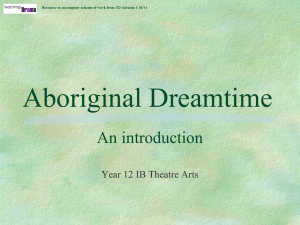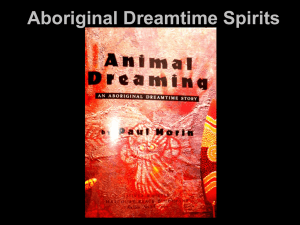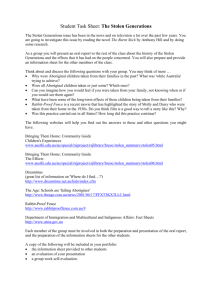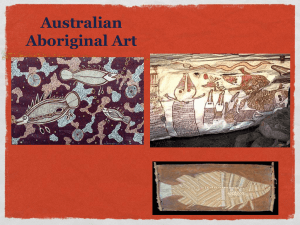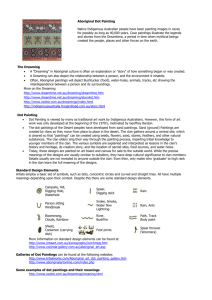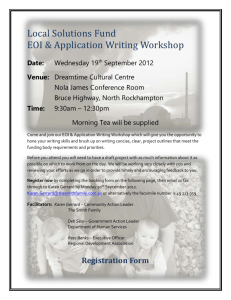the Dreamtime - HOME PAGE We have enjoyed nearly 20 years of
advertisement
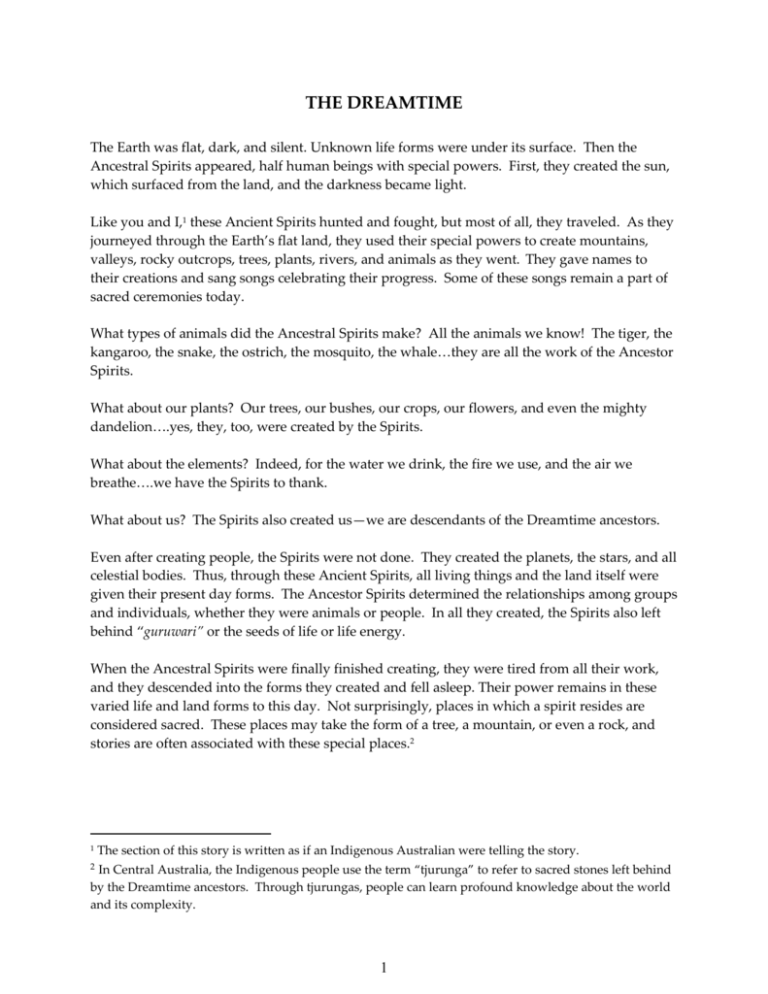
THE DREAMTIME The Earth was flat, dark, and silent. Unknown life forms were under its surface. Then the Ancestral Spirits appeared, half human beings with special powers. First, they created the sun, which surfaced from the land, and the darkness became light. Like you and I,1 these Ancient Spirits hunted and fought, but most of all, they traveled. As they journeyed through the Earth’s flat land, they used their special powers to create mountains, valleys, rocky outcrops, trees, plants, rivers, and animals as they went. They gave names to their creations and sang songs celebrating their progress. Some of these songs remain a part of sacred ceremonies today. What types of animals did the Ancestral Spirits make? All the animals we know! The tiger, the kangaroo, the snake, the ostrich, the mosquito, the whale…they are all the work of the Ancestor Spirits. What about our plants? Our trees, our bushes, our crops, our flowers, and even the mighty dandelion….yes, they, too, were created by the Spirits. What about the elements? Indeed, for the water we drink, the fire we use, and the air we breathe….we have the Spirits to thank. What about us? The Spirits also created us—we are descendants of the Dreamtime ancestors. Even after creating people, the Spirits were not done. They created the planets, the stars, and all celestial bodies. Thus, through these Ancient Spirits, all living things and the land itself were given their present day forms. The Ancestor Spirits determined the relationships among groups and individuals, whether they were animals or people. In all they created, the Spirits also left behind “guruwari” or the seeds of life or life energy. When the Ancestral Spirits were finally finished creating, they were tired from all their work, and they descended into the forms they created and fell asleep. Their power remains in these varied life and land forms to this day. Not surprisingly, places in which a spirit resides are considered sacred. These places may take the form of a tree, a mountain, or even a rock, and stories are often associated with these special places.2 1 The section of this story is written as if an Indigenous Australian were telling the story. 2 In Central Australia, the Indigenous people use the term “tjurunga” to refer to sacred stones left behind by the Dreamtime ancestors. Through tjurungas, people can learn profound knowledge about the world and its complexity. 1 Indigenous Australian3 children learn about the Dreamtime through stories told by their parents, grandparents, and relatives and friends. 4 These stories may be accompanied by rituals and rites that often involve dancing, singing, teaching, storytelling, painting, or the use of totems. The rituals and rites celebrate the creative power of the Ancestral Spirits. Some stories are considered secret or sacred. For these stories, only designated storytellers or custodians are permitted to share the story, and in many cases, only to certain people. For example, there are stories that only married women tell each other. Telling a secret or sacred story to someone who is not eligible to hear it is considered a violation of the law set forth by the Spirits.5 Through these stories, Indigenous Australian children learn about their culture, their ancestry, their values. They learn about the network of relationships between all forms of life, which has been the same since the Ancestor Spirits in the Dreamtime created it. This network is depicted in the Dreamtime Chart on page 5. The children also learn about the concept of a guruwari or a seed, which plays a central role in the Dreamtime and a related concept calling “Dreaming.” Through guruwari, our world today is connected to the Dreamtime. Just as a plant leaves behind a seed from which future plants may grow, any meaningful event, activity, or process that occurs at a given place leaves an imprint or vibration in that place. These imprints call back to the “Dreaming” of the place, the time when the Ancestral Spirits gave form to the place or living being and left its guruwari. All nature and all living things can have “dreamings.” However, becoming aware of the inner dreaming of a place requires a heightened and special state of consciousness. By understanding and knowing the “Dreaming” of places, people learn about their origin, about the spiritual interconnectedness of all things on earth, and about the sacred world. Understanding the meaning of the Dreamtime means living in harmony with the land and with each other. The Dreamtime explains why Indigenous Australians believe that “'We don't own the land, the land owns us.” They believe they have a responsibility to honor and keep the land—and all creation—like it was when the Ancestral Spirits gave it form. " As it was done in the Dreamtime, so it must be done today."6 To an Indigenous Australian, the world as we know it began with the Dreamtime. It represents the beginning of knowledge, and with it, the laws of survival. Dreamtime explains the origin of the universe, how people were created, and how the gods intended people to live. The The term “Aborigine” can have negative connotations. The terms "Aboriginal Australians" or "Aboriginal people" are preferable, but even these terms have some negative colonial associations. According to the website of the Aboriginal Australia Art and Culture Centre, the term "Indigenous Australians" is the most acceptable. The term Aboriginal culture is also considered a non-derogatory phrase. Hence, these terms will be used in this story. Source: http://www.aboriginalart.com.au/ aboriginal_australia.html 4Twenty Dreaming stories told by Indigenous Australian elders are available in text, audio, or video format the following website: http://www.dreamtime.net.au/dreaming/storylist.htm. 5 Source: http://www.dreamtime.net.au/dreaming/secret.htm 3 6 Source: http://www.here-be-dreams.com/lore/dreamtime.html, para. 3 2 Dreamtime represents an oral tradition ten of thousands of years old, a tradition central to Aboriginal culture and religion. Scientists and anthropologists estimate that the Indigenous Australians have lived on the Australian continent for 65,000 years. If that estimate is correct, then the Indigenous Australians have the longest continuous cultural heritage of any people in the world. To Indigenous Australians, it does not make sense to place a date on the Dreamtime because the Ancestral Spirits determined when Dreamtime occurred. It represents a concept that transcends time. Think of traditions you have in your family and culture and how important they are to your life—these traditions are probably less than 100 or 200 years old. Imagine learning about a tradition that your culture has always had, a tradition that has no defined beginning…a tradition that has existed for the entire life of your people. To Indigenous Australians, the Dreamtime is such a tradition. It fosters awareness of the interconnectedness of things in their world and the need to respect the gift of life and the Earth. How might the Indigenous Australian tradition of the Dreamtime help you see the world differently and help you relate more peacefully with each other? —Mary Schaefer Enright Lake Country Institute 3 Dreamtime Chart 4 References Aboriginal Australian Art and Culture Centre. The Dreamtime. Available at: http://aboriginalart.com.au/culture/dreamtime.html Australian Museum. (2004). Dreamtime or Dreaming. Available at: http://www.dreamtime.net.au/ dreaming/dreamtime.htm Australian Museum. (2004). Secret/Sacred Stories. Available at: http://www.dreamtime.net.au/dreaming/secret.htm Chavalas, Mark, & Aldenderfer, Mark S. (Eds..). (2004). Great Events from History: The Ancient World, Prehistory to 476 C.E. Pasadena, CA: Salem Press. Crystal, Ellie. (2008). Australian Dreamtime. Available at: http://www.crystalinks.com/dreamtime.html Marshall, Diana. (2004). Aboriginal Australians. New York: Weigl. Mendham, Trevor. (2008). The Australian Aboriginal Dreamtime. Available at: http://www.here-be-dreams.com/lore/dreamtime.html 5
